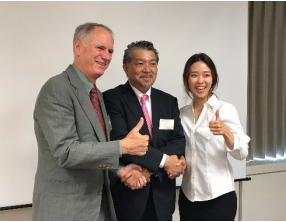For exporters of key U.S. commodities, such as California almonds, Japan remains a challenging and important market, both for its economic value and influence among its Asian neighbors.
Despite a difficult 2018, when weather-driven insect damage led to increased levels of aflatoxin being found in shipments to this market, the Almond Board continues working to address technical and other barriers in order to build a stronger trade relationship with Japan.
“For a number of years, almonds have been subject to higher testing in Japan,” said Julie Adams, vice president of Global Technical and Regulatory Affairs for the Almond Board. “This past year we ran into more issues, mainly related to the higher aflatoxin incidence and procedures they use for sampling and analysis.”
Demand for high quality
Japan has a deserved reputation for demanding some of the highest quality products in its markets for fruits and vegetables, and “it’s not surprising that [reputation] would carry over to almonds,” Adams said.
Japan maintains significant interest in California almonds, importing between 6.1 and 7.9 million pounds annually over the past five years. But this market also occasionally delivers challenging experiences for shippers, with rejected and held consignments increasing in 2018. Japan reportedly tests all incoming shipments, increasing the likelihood that a shipment could be held at the port.
 Data from July 2018.
Data from July 2018.
“Your exposure is much higher with that level of testing. The difficulty in the Japanese market is that there is no protocol for retesting or reprocessing the almonds,” Adams said. “You don’t have a way to rework that consignment or appeal the decision.”
As such, dealing with rejected shipments presents a costly risk for exporters, particularly when there is a situation like last year when the crop quality contributed to an increase in Japanese-held consignments. A further challenge is that the sampling/testing procedures utilized by Japanese port authorities for analyzing incoming shipments introduce further variability in testing results.
“The Japanese approach does not recognize the testing conducted at origin, which makes it difficult to move forward with an equivalent system, similar to what we have established in Europe,” Adams said.
Working for improvements
ABC has been working with the U.S. Department of Agriculture Foreign Agricultural Service (USDA/FAS) to build a better understanding among Japanese authorities of the systems California almond growers and processors have in place to protect food safety.
The Almond Board of California plays an important role in this area, both by disseminating good practices to almond growers and processors in California and by working with Japanese regulators to instill greater confidence in the quality and safety of almond shipments. Staff at the Almond Board seek to address U.S. priorities in Japan, forging links between what regulators need and what producers can provide.
 Last June, ABC president and CEO Richard Waycott delivered a presentation at the annual Japan Nut Association meeting, where he discussed the California almond industry’s opportunities both globally and in the Japanese market.
Last June, ABC president and CEO Richard Waycott delivered a presentation at the annual Japan Nut Association meeting, where he discussed the California almond industry’s opportunities both globally and in the Japanese market.
Adams said the longer-term hope is that Japan will recognize equivalency of testing at origin, perhaps similar to a pre-export check (PEC) system like that used for U.S. almonds exported to the European Union. In fact, almonds are the only U.S. crop whose pre-export checks are currently recognized by the EU — a huge accomplishment that took years of consistent effort and trust-building to achieve.
Adams said she hopes that engaging with Japan on technical elements of sampling and analysis could take some unpredictability out of the equation. But she cautioned that building better systems and trust with Japan will take time, consistent effort and attention to detail. Communication takes place government-to-government, but critical decisions are implemented at the port level — and within the complex systems, procedures and parameters in which ports operate.
“When a lot of these situations come up, there is not a simple solution, not a simple ask,” Adams said. “It’s a long game. We are trying to move things along as quickly as possible, but it does take time to get complex issues resolved particularly when it involves a change in the way a foreign government applies their regulations.”
Published: February 2019